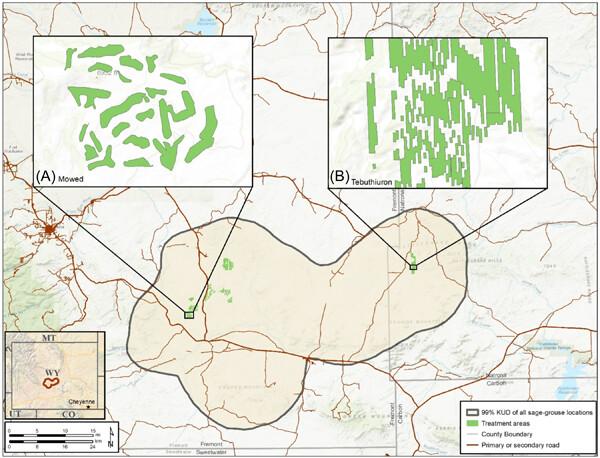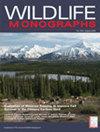怀俄明州大鼠松鸡对山艾草减少治疗的反应大鼠松鸡对怀俄明州艾草控制治疗的反应大鼠松鸡
摘要
植被处理已被广泛用于改善野生动物种群的生存条件。然而,这些努力的有效性往往缺乏严格的评估,以确定这些做法是否对目标物种有效。当在面临多重压力的生态系统中操纵野生动物栖息地时,这一点尤为重要。在过去的一个世纪里,蒿属植物(Artemisia spp.)的生态系统发生了广泛的变化,导致许多相关物种的减少。怀俄明大山艾属(A. tridentata wyomingensis)是分布最广的亚种,为山艾属及伴生野生动物提供了重要的栖息地。山艾树通常采用化学处理、机械处理和规定的焚烧来增加从与山艾树覆盖层竞争中释放的草本饲料种类。尽管许多研究记录了艾草控制对大艾草松鸡(Centrocercus urophasianus)栖息地的负面影响,但仍然提出了改善艾草松鸡和其他艾草依赖物种栖息地的方法。此外,大多数研究都集中在植被的响应上,没有一个研究严格评估这些处理对鼠尾草的直接影响。我们在美国怀俄明州中部发起了一项为期9年(2011-2019)的实验研究,以更好地了解怀俄明州大鼠尾草群落中大鼠尾草对减少鼠尾草治疗的反应。我们评估了2种常见艾草处理对大艾松鸡种群数量和资源选择的影响。我们在2014年冬季和春季实施了割草和施用丁硫脲,并评估了鼠尾草在处理前(2011-2013年)和处理后(2014 - 2019年)对这些管理措施的响应。我们使用620只放射性标记雌性大鼠尾草收集的人口统计学和行为数据来评估对治疗的反应。我们的具体目标是评估治疗如何影响鼠尾草的繁殖成功率和雌性存活率;2)艾草松鸡筑巢、育雏及雌性资源选择;3)植被响应;4)植物和无脊椎动物。我们的研究结果表明,大鼠尾草对刈割和特布硫脲处理的怀俄明州大鼠尾草有中性的人口反应和轻微的回避。刈割和特布硫脲处理均不影响巢存活、幼鸟存活或雌鸟存活。处理前后对筑巢和哺育地点的选择没有差异。雌性在实施治疗前后选择靠近治疗的栖息地;然而,与处理前相比,处理后的选择强度较低,这可能是由于处理后植被和无脊椎动物缺乏响应。多年生牧草盖度和高度在处理地和对照地之间存在时间差异,但无系统差异。植被盖度和物种丰富度每年都有变化,但与两种处理类型无关。经过2年或6年休牧处理的草地多年生牧草盖度、牧草高度、牧草盖度和牧草物种丰富度与不休牧处理的草地相比均没有增加。最后,在处理后的任何年份,刈割或丁硫脲场地的处理地块与对照地块之间的牧草和无脊椎动物干质量没有差异。我们的研究结果增加了大量的证据,表明使用怀俄明州大山艾草植被群落的艾草松鸡对山艾草操纵处理没有积极的反应。专注于维护大片未受干扰的艾草丛的管理实践将最有利于艾草松鸡种群和其他依赖艾草丛草原的物种的持续存在。

Vegetation treatments have been widely implemented in efforts to enhance conditions for wildlife populations. Yet the effectiveness of such efforts often lack rigorous evaluations to determine whether these practices are effective for targeted species. This is particularly important when manipulating wildlife habitats in ecosystems that are faced with multiple stressors. The sagebrush (Artemisia spp.) ecosystem has been altered extensively over the last century leading to declines of many associated species. Wyoming big sagebrush (A. tridentata wyomingensis) is the most widely distributed subspecies, providing important habitats for sagebrush-obligate and associated wildlife. Sagebrush often has been treated with chemicals, mechanical treatments, and prescribed burning to increase herbaceous forage species released from competition with sagebrush overstory. Despite many studies documenting negative effects of sagebrush control on greater sage-grouse (Centrocercus urophasianus) habitat, treatments are still proposed as a means of improving habitat for sage-grouse and other sagebrush-dependent species. Furthermore, most studies have focused on vegetation response and none have rigorously evaluated the direct influence of these treatments on sage-grouse. We initiated a 9-year (2011–2019) experimental study in central Wyoming, USA, to better understand how greater sage-grouse respond to sagebrush reduction treatments in Wyoming big sagebrush communities. We evaluated the influence of 2 common sagebrush treatments on greater sage-grouse demography and resource selection. We implemented mowing and tebuthiuron application in winter and spring 2014 and evaluated the pre- (2011–2013) and post-treatment (2014–2019) responses of sage-grouse relative to these management actions. We evaluated responses to treatments using demographic and behavioral data collected from 620 radio-marked female greater sage-grouse. Our specific objectives were to evaluate how treatments influenced 1) sage-grouse reproductive success and female survival; 2) sage-grouse nesting, brood-rearing, and female resource selection; 3) vegetation responses; and 4) forbs and invertebrates. Our results generally suggested neutral demographic responses and slight avoidance by greater sage-grouse in response to Wyoming big sagebrush treated by mowing and tebuthiuron. Neither mowing nor tebuthiuron treatments influenced nest survival, brood survival, or female survival. Selection for nest and brood-rearing sites did not differ before and after treatments. Females selected habitats near treatments before and after they were implemented; however, the strength of selection was lower after treatments compared with pre-treatment periods, which may be explained by a lack of response in vegetation and invertebrates following treatments. Perennial grass cover and height varied temporally yet did not vary systematically between treatment and control plots. Forb cover and species richness varied annually but not in relation to either treatment type. Perennial grass cover and height, forb cover, and forb species richness did not increase within mowed or tebuthiuron-treated areas that received 2 or 6 years of grazing rest compared with areas that received no grazing rest. Finally, forb and invertebrate dry mass did not differ between treated plots and control plots at mowing or tebuthiuron sites in any years following treatments. Results from our study add to a large body of evidence that sage-grouse using Wyoming big sagebrush vegetation communities do not respond positively to sagebrush manipulation treatments. Management practices that focus on the maintenance of large, undisturbed tracts of sagebrush will best facilitate the persistence of sage-grouse populations and other species reliant on the sagebrush steppe.

 求助内容:
求助内容: 应助结果提醒方式:
应助结果提醒方式:


